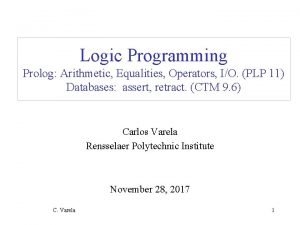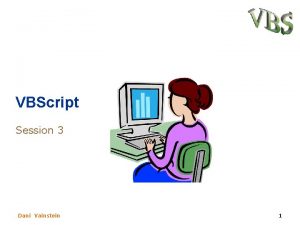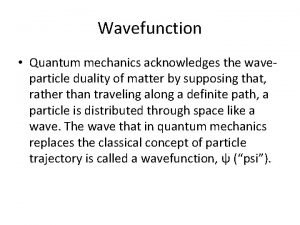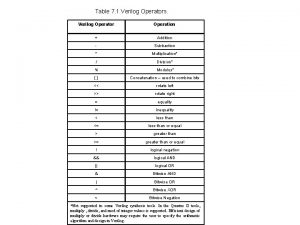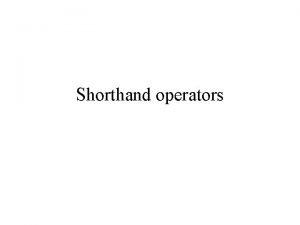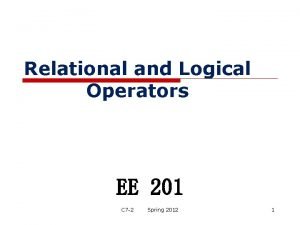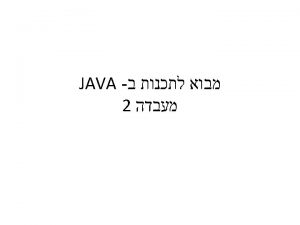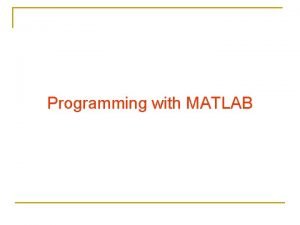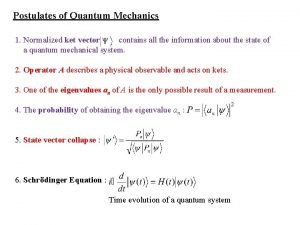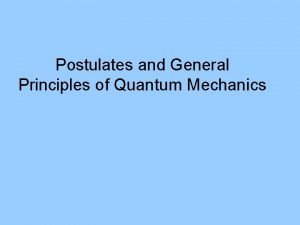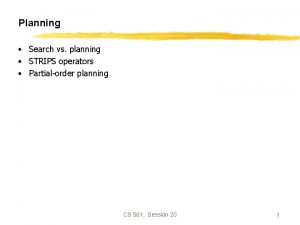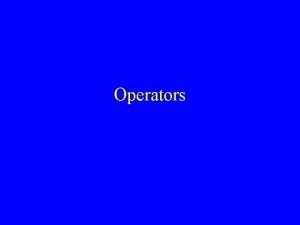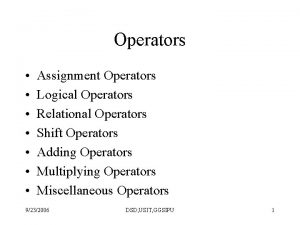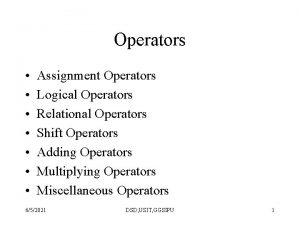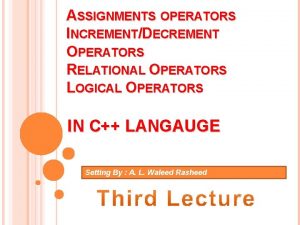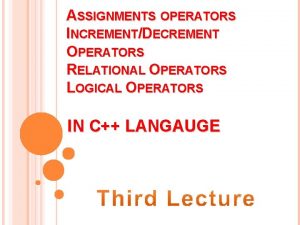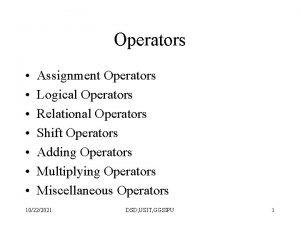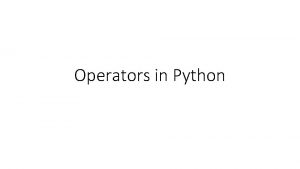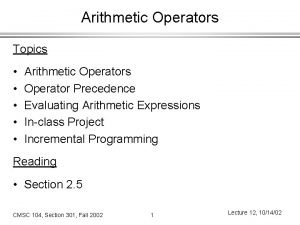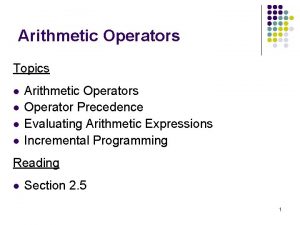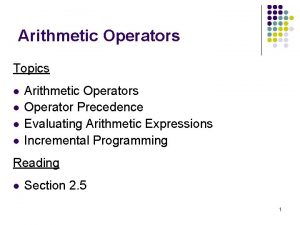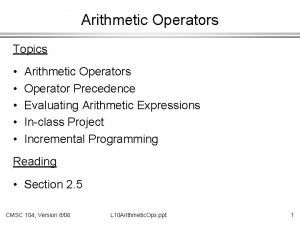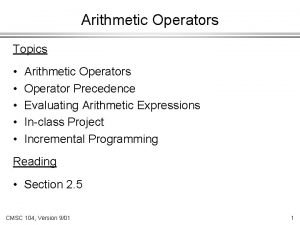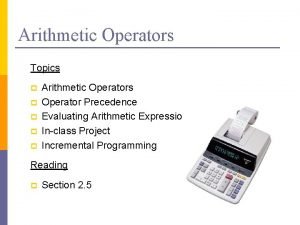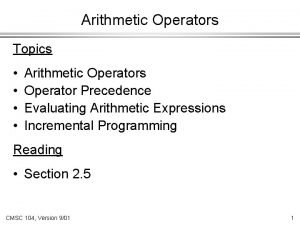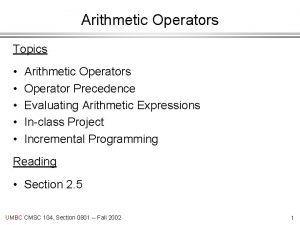Chapter Three Operators Arithmetic 1 Chapter three 3
















- Slides: 16

Chapter Three: Operators, Arithmetic 1

Chapter three: 3. 3 3. 4 2 Operator notation Arithmetic

3. 3 Operator notation 2*a+b*c � + and * are operators. Also, the called infix operators (appears between the two arguments) � 2, a, b, and c are arguments The expression can be represented as tree, and written as Prolog terms with + and * as functor +(*(2, a), *(b, c)) 2 3 + * * a b c

3. 3 Operator notation 2 * a + b * c � Prolog accept infix notation, however, it is only the external representation, which automatically converted into the usual form of Prolog terms. � The output will be in its external , infix form. Precedence rule: The operator with the highest precedence is the principal functor of the term otherwise using parentheses. 4

3. 3 Operator notation �A programmer can define her own operators. e. g. we can define the atoms has and support as infix operators and then write Prolog facts like: peter has information. floor support table. these fact are exactly equivalent to: has(peter, information). support(floor, table). How to define operators? using special clauses (directives), that must appear in the program before any expression containing that 5 operator.

3. 3 Operator notation � To define the atoms has as infix operator, we write the directive: : -op(600, xfx, has). 600 is the precedence of has ( assume the range between 1 and 1200) xfx is the type ( x functor x, infix) Note: no operation on data is associated with an operator (except in very special cases). Operators are normally used , as functors, only to combine objects into structures and not to invoke actions on data. 6

3. 3 Operator notation � Types of operators: � Infix xfy � Prefix fx fy � Postfix xf yfx yf There is a difference between ‘x’ and ‘y’ in the types of operators. The precedence of argument: � If an argument is enclosed in parentheses or it is an unstructured object then its precedence is 0 � If an argument is a structure then its precedence is equal to the precedence of the principal functor. x precedence < operator precedence Y precedence ≤ operator precedence 7

3. 3 Operator notation e. g. Øa – b – c Ø Normally calculated as (a-b)-c and NOT a-(b-c) Ø To achieve that, the operator ‘–’ has to be defined as yfx 8

3. 3 Operator notation : -op(P, xfy, name). � Where P is the priority of the operators(between 1 and 1200) � xfy indicates if the operator is infix(xfx, xfy, yfx), prefix(fx, fy) or postfix. � The name is, of course, the name of the operator. � Note that the priority 1200, has the highest priority. � Prolog has already predefined operators ( see page 78 ) 9

3. 4 Arithmetic Some of the predefined operators can be used for basic arithmetic operations (invoke built-in procedures): Calculating Comparing: �+ addition �> �– subtraction �< �* multiplication � >= �/ division � =< � ** power � =: = � // integer division � == � modulo 10 cos (X) � atan (X) � log (X) � exp (X) �

3. 4 Arithmetic Example: ? - X = 1 + 2 X=1+2 We use is to force the evaluation (invoke the procedure) ? - X is 1 + 2 X=3 ? - X is 5/2, Y is 5//2, Z is 5 mod 2 X = 2. 5 Y=2 Z=1 11

3. 4 Arithmetic Example: ? - 277*37 > 10000. Yes Suppose we have a relation born that relates the names of people with their birth years. How can we retrieve the names of people born between 1980 and 1990? ? - born(Name, Year), Year >= 1980, Year =< 1990. 12

3. 4 Arithmetic Example: ? - 1+2 = 2+1 No (matching) ? - 1+2 =: = 2+1 Yes ? - 1+A = B+2 A=2 B=1 13

3. 4 Arithmetic Example ( the greatest common divisor) The relation: gcd(X, Y, D) Given two integers X, and Y, their greatest common divisor D, can be found according to three cases: 1. If X and Y are equal, then D is equal to X 2. If X < Y, then D is equal to the greatest common divisor of X and the difference Y – X 3. If X > Y, then do the same as in case 2 with X and Y interchanged. gcd(X, X, X). gcd(X, Y, D): - X<Y, Y 1 is Y-X, gcd(X, Y 1, D). gcd(X, Y, D): - X>Y, gcd(Y, X, D) 14

3. 4 Arithmetic Example ( the length of list, number of items) The relation: length (List, N) We want to count the elements in a list List and instantiate N to their number, we have two cases: 1. If the list is empty, then its length is 0 2. If the list is not empty, then List = [Head|Tail]; then its length is equal to 1 plus the length of the tail Tail. length([], 0). length([-|Tail], N): - length(Tail, N 1), N is 1 + N 1. ? - length([a, b, c], N). N=3 15

Homework � 3. 1 3. 9 and 3. 11 � 3. 12 3. 21 16
 Logical operators in prolog
Logical operators in prolog Logical expressions
Logical expressions Vbscript xor
Vbscript xor Tabel kebenaran operator logika
Tabel kebenaran operator logika Expectation value of hermitian operator
Expectation value of hermitian operator Verilog operators table
Verilog operators table What is shorthand operator in java
What is shorthand operator in java Relational operators
Relational operators Quantum mechanics postulate
Quantum mechanics postulate Mainstring
Mainstring Matlab relational operators
Matlab relational operators Spin 1 operators
Spin 1 operators Operators in quantum mechanics
Operators in quantum mechanics Pl sql meaning
Pl sql meaning Strips operators
Strips operators Pest control operators of california
Pest control operators of california Perl assignment operators
Perl assignment operators
